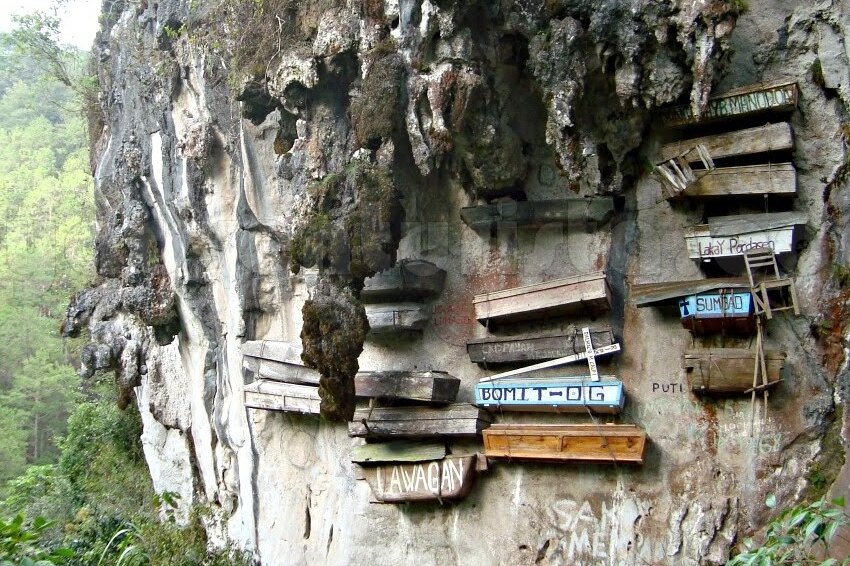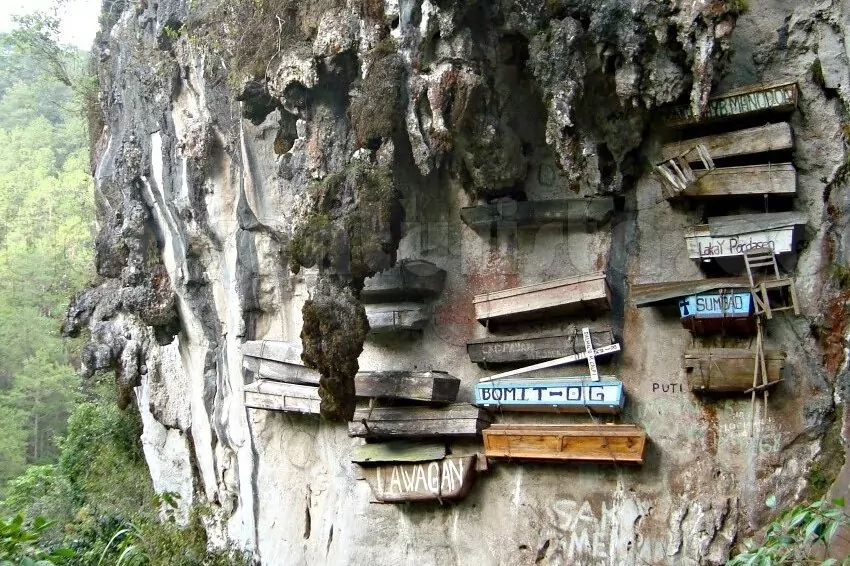

(c) Pinoy Adventurista
At the entrance of Sagada’s Marlboro Hill on November 28, tourists stomped their feet and rubbed their hands to fight off the chilly predawn air.
At 4 a.m., when the temperature was between 16 and 18 degrees Celsius, the workers at the admissions table ensured that only guests with tour guides and stubs from the municipal tourism office were permitted to enter.
The reward for more than an hour of hiking is a hilltop where the rising sun breaks through a sea of clouds.
Decades ago, the Department of Tourism dubbed Sagada a “mystical sanctuary” because of these and other sceneries.
Tourists can climb back from Lamagan, the traditional name for the hill, after sunrise. Alternately, they can opt for the hard four- to five-hour hike up Blue Soil Hill, which varies in pace.
The hill’s name (locals refer to it as “Kaman-utek”) reflects the hypnotic blue earth in a kilometer-square limestone area surrounded by rocks and trees. The effect is ascribed to the high copper sulfate concentration of the soil and is claimed to be more noticeable when the soil is moist with dew.
“The throng is larger than in previous days, but a long cry from what it was before the pandemic,” said tour guide Brenda Doco as she searched the crowd for the best spot to photograph the sunrise’s first rays.
Before COVID-19 drove the country into a lengthy quarantine, travelers had to wait in line for the greatest sunrise photo ops, according to Doco. The same was true in Blue Soil.
The tour guide is hopeful that the next Yuletide and Holy Week breaks would attract more tourists, but he predicts that the number will not recover to pre-pandemic levels very soon.
The municipal council aimed to attract at least 2,000 vacationers between October 29 and November 2. Just over a thousand people attended.
Based on fee collection, the average annual tourist arrival number from 2017 to 2019 was 194,467, or around 531 people per day.
“Tourism is Sagada’s most reliable source of local revenue,” Municipal Treasurer Alfred Macalling stated in an interview on November 28.
The town’s tourism sector generated P13.98 million in revenue in 2019 alone, with the visitor registration fee accounting for P9.02 million, or 65 percent of the overall revenue.
During the period, there were additionally 173 registered inns, motels, and guides, generating at least P238,700 in additional income for the renewal of the mayor’s business license.
The town’s per-tourist fee used to be P40, but it increased to P50 in August 2018, with a provision to add P10 annually thereafter, with the exception of 2019 when the increase was suspended.
Macalling anticipated that 2020 will be a prosperous year for tourism.
Sagada’s tourist-fee revenues totaled P1,790,000 before to the town’s border closure in March, which marked the beginning of the country’s two-year lockdown.
Its overall local income for 2020, including all other local taxes and fees, was only P6.61 million, which was less than the amount collected in 2019 from tourist fees.
In 2021, revenue from local businesses fell further to $3,761,000.
Prior to the March 2020 shutdown, “many took out loans, buildings were mortgaged, and investments were made for the peak season,” Gwen Gaongen, head of the Sagada Inn Keepers and Homestay Owners Association (SIHA), told Rappler.
She recalled that it was the second week of February that the LGU first convened a meeting to explore potential COVID-19 situations.
Despite the fact that there was a significant lack of knowledge on its severity and social impact, “many still invested, with restaurants and inns hoarding goods for Holy Week.”
“Early in the pandemic, local business owners were still relatively unconcerned,” stated Gaongen. Even food and supplies were provided for frontline workers, quarantine sites, and checkpoints.
“However, when the shutdown stretched on and December arrived, everyone was concerned about their debts and properties,” stated the president of the SIHA.
The epidemic altered the economic and social landscape of the city.
Even when Sagada reopens in December 2021 with P100 entrance prices, the community has not yet recovered from the budgetary shock.
In contrast to the pre-pandemic environment, “we are still working to boost the [number of] tourists coming in,” the treasurer explained.
Macalling emphasized that economic damage extends beyond local cash, highlighting the loss of local jobs and other prospects.
In 2022, just 131 of the 219 registered tour guides in 2019 remained.
“Even when we launched in December 2021, it was still tough due to the numerous limitations, and as a result, the tour cost increased,” Gaongen said.
SIHA and other stakeholders were required to push the LGU to relax the restrictions until a solution was reached with the local task group.
“Recovery was never simple to begin with, and the epidemic exacerbated the difficulty. But at least we no longer rely solely on loans for capital,” Gaongen stated.
“We have yet to recoup the peak number of arrivals, which is an issue in and of itself. Do we have to return to this type of tourism because we are in need?” She stated.
As President Donald Trump declared economic independence through new tariffs he placed significant harm on developing countries in Southeast Asia…
Once again crowned the world's best entrepreneurship nation in the Global Entrepreneurship Monitor (GEM) Report, the UAE has claimed the…
At age 24 Mykhailo Polyakov from America violated regulations when he came to North Sentinel Island which authorities guard to…
The much awaited action thriller Runner is getting boosted with a stellar cast. Directed by Scott Waugh, the film has…
Emirates has launched a new product, Emirates Courier Express, which promises faster, more reliable, flexible express shipping to customers around…
Nintendo has announced the new Switch 2 to stir the gaming world with some fabulous features. This console of the…
This website uses cookies.
Read More